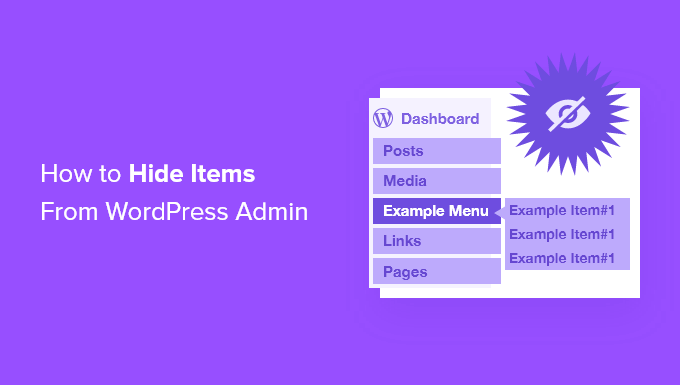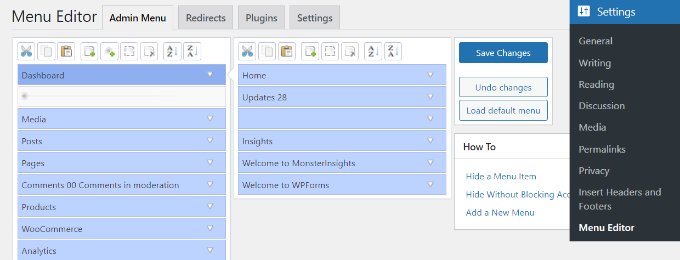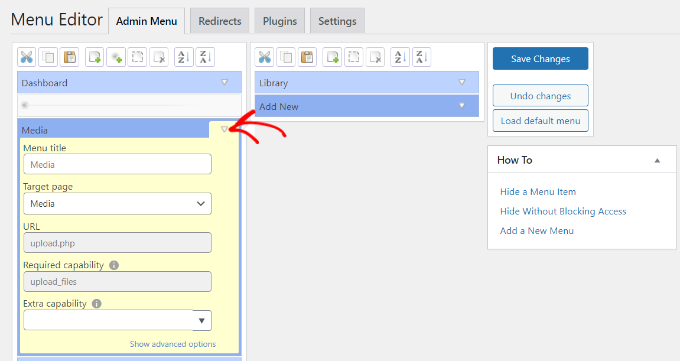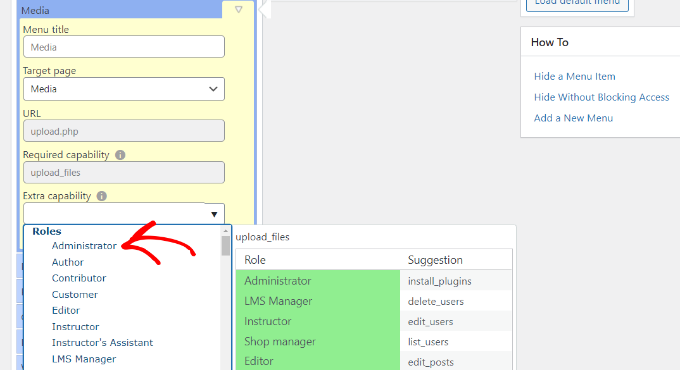Dopo aver gestito siti web in WordPress per anni, abbiamo scoperto che l’area di amministrazione di WordPress può diventare ingombra di voci di menu non necessarie. Questo è particolarmente vero quando si gestisce un sito con più autori o si gestiscono siti web per clienti.
Ripulire l’area di amministrazione aiuta il team a concentrarsi solo sulle opzioni essenziali di cui ha bisogno, senza l’ingombro di caratteristiche usate raramente. È un modo semplice ma efficace per snellire il processo di gestione di WordPress e migliorare l’esperienza dell’utente per il team o i clienti.
In questo articolo vi mostreremo come nascondere gli elementi non necessari dall’area di amministrazione di WordPress, aiutandovi a creare uno spazio di lavoro più pulito ed efficiente per voi e per i vostri utenti.

Perché nascondere le voci del menu Admin in WordPress?
Nell’area di amministrazione di WordPress ci sono molti menu, sottomenu, opzioni e impostazioni di temi e plugin che si possono modificare in qualsiasi momento. Alcune di queste voci di menu dell’amministrazione di WordPress includono i widget della dashboard, l’area di modifica delle pubblicazioni, i plugin, l’aspetto, gli strumenti e altro ancora.
Tuttavia, la maggior parte di queste opzioni di menu non viene utilizzata quotidianamente e finisce per ingombrare la schermata di amministrazione. Se gestite un sito WordPress con più autori o se avete clienti che visitano l’area di amministrazione, è buona norma ripulire il pannello di amministrazione di WordPress.
Dovreste mantenere solo i menu e le opzioni utili per i vostri autori e clienti e nascondere il resto dei sottomenu.
È anche possibile disattivare gli elementi in base ai ruoli degli utenti, creando interfacce di amministrazione diverse per gli utenti con ruoli e capacità diverse sul sito WordPress.
Detto questo, vediamo come rimuovere le voci di menu non necessarie dall’amministrazione di WordPress.
Nota: questa guida riguarda il menu di amministrazione del backend che un utente registrato sul vostro sito vede quando accede.
Se volete personalizzare i menu di navigazione che tutti i visitatori del vostro sito web vedono, allora dovreste consultare la nostra guida passo-passo su come aggiungere un menu di navigazione in WordPress.
Video tutorial
Se preferite le istruzioni scritte, continuate a leggere.
Come nascondere specifiche voci del menu Admin di WordPress
Il modo più semplice per nascondere i menu e gli elementi dalla dashboard di WordPress è utilizzare il plugin Admin Menu Editor. Si tratta di un plugin gratuito per WordPress che consente di modificare i titoli dei menu, gli URL, le icone e altro ancora.
È inoltre possibile nascondere le voci di menu dalla barra laterale di amministrazione, impostare i permessi per i ruoli degli utenti e trascinare le voci di menu per organizzare la barra di amministrazione di WordPress.
Per prima cosa, è necessario installare e attivare il plugin Admin Menu Editor. Per maggiori dettagli, consultate la nostra guida su come installare un plugin di WordPress.
Dopo l’attivazione, potete andare su Impostazioni ” Editor di menu dalla vostra dashboard di WordPress. In questa pagina di impostazioni, vedrete tutte le voci di menu e sottomenu sotto la scheda “Admin Menu”.

È possibile trascinare e rilasciare le voci di menu per riorganizzarne l’ordine. È inoltre possibile rimuovere o aggiungere nuove voci di menu.
Quindi, fare clic sulla freccia verso il basso di ogni voce di menu per visualizzare altre opzioni. È possibile rinominare il titolo del menu, cambiare la pagina di destinazione e altro ancora.

Per nascondere una voce di menu dell’amministratore a un utente specifico, è sufficiente fare clic sul menu a discesa “Capacità extra”. Successivamente, è possibile scegliere il ruolo dell’utente che può visualizzare la voce di menu tra le opzioni disponibili.
Ad esempio, supponiamo di voler nascondere il menu Media e i suoi sottomenu per tutti i ruoli utente, tranne che per l’amministratore. Per farlo, basta fare clic sul menu a discesa “Capacità extra” e scegliere “Amministratore” tra i ruoli.

Al termine, salvare le modifiche.
Ora, la voce di menu Media sarà visibile solo al ruolo di Amministratore e sarà nascosta agli altri ruoli utente.
Se qualcuno tenta ancora di accedere alla voce di menu nascosta digitando l’URL, viene visualizzato il messaggio di errore “Non hai i permessi sufficienti per accedere a questa pagina di amministrazione”.

A questo punto è possibile ripetere questi passaggi per nascondere altre voci del menu di amministrazione e plugin per diversi utenti.
Per ulteriori modi di personalizzare l’amministrazione di WordPress, potete consultare queste guide:
- Suggerimenti vitali per proteggere l’area amministrativa di WordPress (aggiornato)
- Come dare un’etichetta bianca alla dashboard dell’amministrazione di WordPress
- Come aggiungere avvisi amministrativi personalizzati in WordPress
- Come proteggere con password la directory di amministrazione di WordPress (wp-admin)
- Come cambiare lo schema dei colori dell’amministrazione in WordPress (facile e veloce)
Speriamo che questo articolo vi abbia aiutato a nascondere gli elementi non necessari dall’area di amministrazione di WordPress. Potreste anche voler dare un’occhiata alla nostra selezione dei migliori plugin per il monitoraggio e il registro delle attività di WordPress e alla nostra guida su come disabilitare la barra di amministrazione di WordPress.
Se questo articolo vi è piaciuto, iscrivetevi al nostro canale YouTube per le esercitazioni video su WordPress. Potete trovarci anche su Twitter e Facebook.





Austin
Hello:
I am trying to remove the widget tab from the dropdown menu under the page url for editors.
When you are logged in and have hit the “visit site” option under the site url in the upper left hand corner, then you hover back over the site url, it now shows options in the drop down, i.e dashboard, widgets, menu. I would like to remove widgets from this menu for editors.
Thanks
WPBeginner Comments
Something like Widgets would be under the Appearance dropdown.
In the Admin Menu Editor plugin settings, you would select the Appearance dropdown, and then the Widget dropdown on the right menu.
You can then assign the ‘Extra capability’ needed for that feature.
Jiří Vaněk
I have been using the website every day for about a year and a half. During that time, I have already installed almost everything I need for my work, but the truth is that it now has twice as many items and practically I need maybe half of it. Is it necessary to install a plugin, or can some parts of the menu be hidden with a snippet? He would like to avoid another plugin.
WPBeginner Support
The code required in a snippet would be a bit beyond what we would recommend for beginners which is why we recommend the plugin. For concerns about using a plugin we would recommend taking a look at our article below:
https://www.wpbeginner.com/opinion/how-many-wordpress-plugins-should-you-install-on-your-site/
Admin
JAVED AKHATR NAYYER
this is good method but how can i again showed all menues please discribe
WPBeginner Support
You would want to use the load default menu button on the side to return to the default menu.
Admin
Howard Hue
Hey. Don’t use a plugin just use a conditional IF statement. There are a bunch you can use but here are a couple good ones to add to your functions or custom functions file.
If you’re savvy with WP and some light coding this is the best alternative to a plugin by far, in my opinion.
// Remove a main menu page link on admin/dash
remove_menu_page( ‘$mainmenu-sluge’ );
// Remove a main menu’s submenu link on admin/dash
remove_submenu_page( ”$mainmenu-slug”, ”$submenu-slug”);
Hope this helps.
WPBeginner Support
Thank you for sharing this, our guides are designed for beginners that don’t have coding knowledge first but for those looking for an alternative, this could be a helpful option.
Admin
Kumar
we have wordpress site, in our admin panel settings and Appearance not available, don”t why…whats the problem…
WPBeginner Support
Your user may not be an admin user for your site if you had someone else set it up for you.
Admin
Kenneth Bryan Domingo
Hi! I want to hide the tutorial tab on my menu but I can’t find it can anyone help me? I can send you pictures of it. Thanks!
WPBeginner Support
If the menu is added via a plugin then you would want to reach out to your plugin’s support and they should be able to help you with hiding it.
Admin
vincent
Is the tick displayed or hidden? Is there a suggested role setting? Specific teaching
WPBeginner Support
If it is checked/ticked then that item would be removed from that level’s view
Admin
Hurab
please guide how to disable the notification for editor. i have tried already but still can see.
Pleaseguide
WPBeginner Support
There should be the option to disable admin notices depending on the notices you no longer want to appear.
Admin
KITHO
How can I hide some menu items for only certain Administrators not all of them? Because there are admins that I don’t want to touch on any design/customizations.
Leon Lalaev
Use this function in theme function p h p file
Ron
Hi,
Any news/info/solution/… about those flags! I have just installed plugin (super cool I must say), add demo user, playing with restrictions, logged in on another machine as demo user… ok. Done this “To view your changes to the menu you need to navigate away from the Adminimize settings page.” several times…
But on the end of a day if this demo user would call me and said “I don’t see Woocommerce”… Well demo user! I see no flags on your Woo…
Good for me to add demo user. I think I said enough.
Br,
Naomi
Thank you, I have just installed and worked fine!
Sreeny
Wow !
Very useful article.
Superb !
Julie
I didn’t know this plugin, it’s amazing! Thank you so much for making me discover it, you saved my life haha
Giovanni
Hello.
After the last update 1.10.1 no longer see the flags of the things that I selected.
How can I do?
Thanks in advance.
Cliff
Thank you.
This was very helpful.
Sherry
If I have role1 and role2 and each role has their own sidebar widget. Is there a way to add a hook so that when role1 is logged in they will only see sidebar widget1 and when role2 is logged in they will only see sidebar widget2. (see and be able to edit their own widget)
Currently adminimize allows me to show or hide sidebar so there is no way to specify which sidebar widget.
Thanks
Patrick
This saved me alot! I have this annoying client that keeps on destroying a customized (hard-coded) theme by resetting the appearance theme option on purpose to keep on demanding for unnecessary revisions. Now they can only edit posts which is suppose to be what the client should only be doing. Thanks alot for this!
Thanks alot for this!
robert
i think is better to use of hack rather than using too many plugins and most of them has bug also, which allow hackers kill your website! for example here i share you some of those codes to hide admin items:
function remove_dashboard_widgets() {
global $menu,$submenu;
global $current_user;
get_currentuserinfo();
if ($current_user->ID != 1) { // only admin sees the whole thing
// $menu and $submenu will return fo all menu and submenu list in admin panel .
$menu[2] = “”; //Dashboard
$menu[5] = “”; // Posts
$menu[15] = “”; //Links
$menu[25] = “”; //Comments
$menu[65] = “”; //Plugins
unset($submenu[‘themes.php’][5]); //themes
unset($submenu[‘themes.php’][12]); //editor
}
}
add_action(‘admin_head’, ‘remove_dashboard_widgets’);
Linda
Robert, your information is interesting. But as a non-coder, I wouldn’t know where to put this little nugget. Any more info on that?
Gozie
you’re right, and I used your code, it worked well. but how did you come up with this and how can I use it for more security like disabling access to some other sections of my website. thanks.
gina
I have comments deactivated in adminimize in the menu options but it stil shows up on the admin screen for all users. I would like only admins and editors to see the comments.
Matt Rock
While the article is promising, as of this writing the plugin is compatible up to version 3.6 and hasn’t been updated in almost a year.
I currently update the functions file using a great tutorial by Justin Tadlock (http://tinyurl.com/qda95ap) but this plugin looks like it would really streamline the process.
Does anyone know of a similar plugin which is actively maintained and
compatible with the latest version of wordpress (currently 3.9)?
e-rik
While the possibilities of this plugin are very nice and extensive, It misses one giant thing: the possibility to minimize the dashboard for certain administrators. On my client’s sites I want to maintain full access on my own admin account and limit the client’s admin acount(s). Or did I miss something and is this possible?
Itay
You will need to use it in cojunction with
User Role Editor plugin.
WPBeginner Staff
No, it does not.
WPBeginner Staff
Yes it is multisite compatible. We will try to cover the scaling of multisite WordPress in some future article. Thanks for the suggestion. However, for the time being try using plugins that are well coded, come highly recommended, and are well documented.
lucky
I installed it on multisite but wanted to control these things network wide not site by site. I could see no way to do that.
ThatK1dB
This is great. i just had a client with no knowledge of WP and had to disable certain features so he didn’t blow this thing up. This plugin has helped. Also, very easy to use.
Thanks!
Jeff
I agree. Same problem. Easy to deactivate permissions, but an editor in itself does not have access to certain features which mean I need to give admin role to managers of the site. Then I “deactivate” features and me too as an admin lose the same permissions! Weird.
This plugin is undiectional – yuo can deactivate but not asctivate permissions.
Itay
You will need to use it in cojunction with
User Role Editor plugin.
aathi
is it multisite compatible ? And also can you do a post on scaling a multisite along with plugins ?it will be useful for us.We are finding it difficult to find info about wordpress multisite. Your help will be appreciated.
RW
This looks like an amazing plugin! Wow, I wonder if something this powerful adds a lot of weight and queries to the database. Does this plugin slow down editing the site?